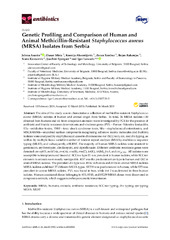Приказ основних података о документу
Genetic Profiling and Comparison of Human and Animal Methicillin-Resistant Staphylococcus aureus (MRSA) Isolates from Serbia
| dc.creator | Ašanin, Jelena | |
| dc.creator | Mišić, Dušan | |
| dc.creator | Aksentijević, Ksenija | |
| dc.creator | Tambur, Zoran | |
| dc.creator | Rakonjac, Bojan | |
| dc.creator | Kovačević, Ivana | |
| dc.creator | Spergser, Joachim | |
| dc.creator | Loncarić, Igor | |
| dc.date.accessioned | 2020-06-03T14:34:50Z | |
| dc.date.available | 2020-06-03T14:34:50Z | |
| dc.date.issued | 2019 | |
| dc.identifier.issn | 2079-6382 | |
| dc.identifier.uri | https://vet-erinar.vet.bg.ac.rs/handle/123456789/1758 | |
| dc.description.abstract | The aim of this study was to characterize a collection of methicillin-resistant Staphylococcus aureus (MRSA) isolates of human and animal origin from Serbia. In total, 36 MRSA isolates-30 obtained from humans and six from companion animals-were investigated by PCR for the presence of antibiotic and biocide resistance determinants and virulence genes (PVL-Panton-Valentine leukocidin, ETs-exfoliative toxins, TSST-toxic shock syndrome toxin, SEs-staphylococcal enterotoxins, and MSCRAMMs-microbial surface components recognizing adhesive matrix molecules and biofilm). Isolates were analyzed by staphylococcal cassette chromosome mec (SCCmec), spa, and dru typing, as well as by multiple locus variable number of tandem repeat analyses (MLVA), multilocus sequence typing (MLST), and subsequently, eBURST. The majority of human MRSA isolates were resistant to gentamicin, erythromycin, clindamycin, and ciprofloxacin. Different antibiotic resistance genes were detected: aac-aphD, ant(6 )-Ia, erm(A), erm(B), erm(C), tet(K), tet(M), fexA, and cat(pC221). All isolates were susceptible to teicoplanin and linezolid. SCCmec type III was prevalent in human isolates, while SCCmec elements in animals were mostly nontypeable. t037 was the predominant spa type in human and t242 in animal MRSA isolates. The prevalent dru type was dt11c in human and dt10a in animal MRSA isolates. MRSA isolates exhibited 27 different MLVA types. ST239 was predominant in human, while ST5 was prevalent in canine MRSA isolates. PVL was found in two, while tsst-1 was detected in three human isolates. Human-associated clones belonging to ST5, ST45, and ST239 MRSA clones were discovered in companion animals, which suggests anthropozoonotic transmission. | en |
| dc.publisher | MDPI, Basel | |
| dc.relation | info:eu-repo/grantAgreement/MESTD/Technological Development (TD or TR)/31079/RS// | |
| dc.rights | openAccess | |
| dc.source | Antibiotics-Basel | |
| dc.subject | MRSA | en |
| dc.subject | humans | en |
| dc.subject | animals | en |
| dc.subject | antibiotic resistance | en |
| dc.subject | SCCmec typing | en |
| dc.subject | dru typing | en |
| dc.subject | spa typing | en |
| dc.subject | MLVA | en |
| dc.subject | MLST | en |
| dc.title | Genetic Profiling and Comparison of Human and Animal Methicillin-Resistant Staphylococcus aureus (MRSA) Isolates from Serbia | en |
| dc.type | article | |
| dc.rights.license | ARR | |
| dcterms.abstract | Aшанин, Јелена; Aксентијевић, Ксенија; Лонцарић, Игор; Мишић, Душан; Ковачевић, Ивана; Спергсер, Јоацхим; Ракоњац, Бојан; Тамбур, Зоран; | |
| dc.citation.volume | 8 | |
| dc.citation.issue | 1 | |
| dc.citation.spage | 26 | |
| dc.citation.other | 8(1): 26 | |
| dc.citation.rank | M21 | |
| dc.identifier.wos | 000464147600002 | |
| dc.identifier.doi | 10.3390/antibiotics8010026 | |
| dc.identifier.pmid | 30884836 | |
| dc.identifier.scopus | 2-s2.0-85064243952 | |
| dc.identifier.fulltext | https://vet-erinar.vet.bg.ac.rs/bitstream/id/719/1757.pdf | |
| dc.type.version | publishedVersion |

